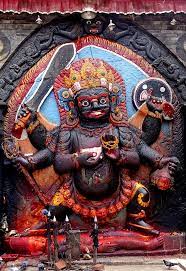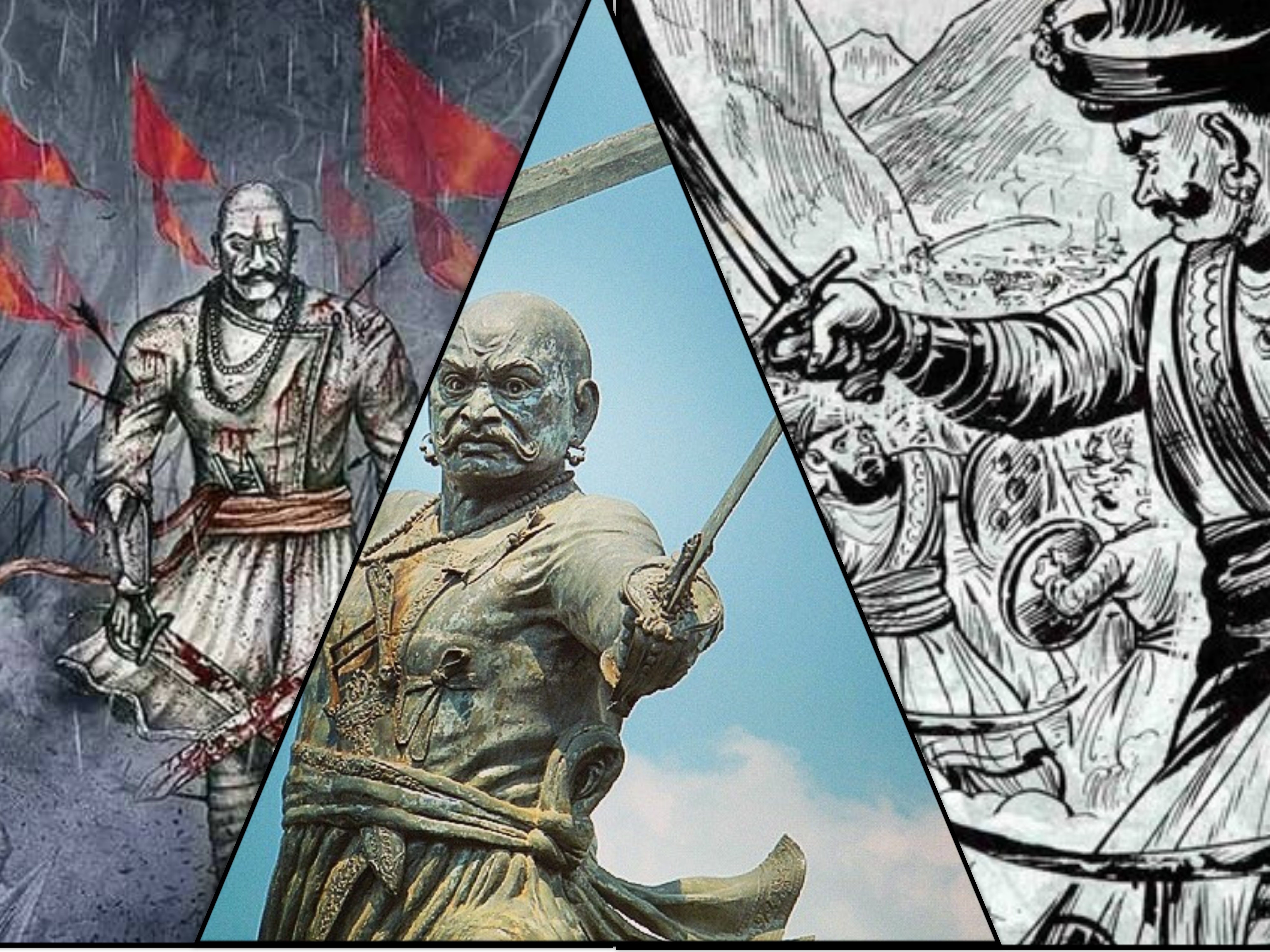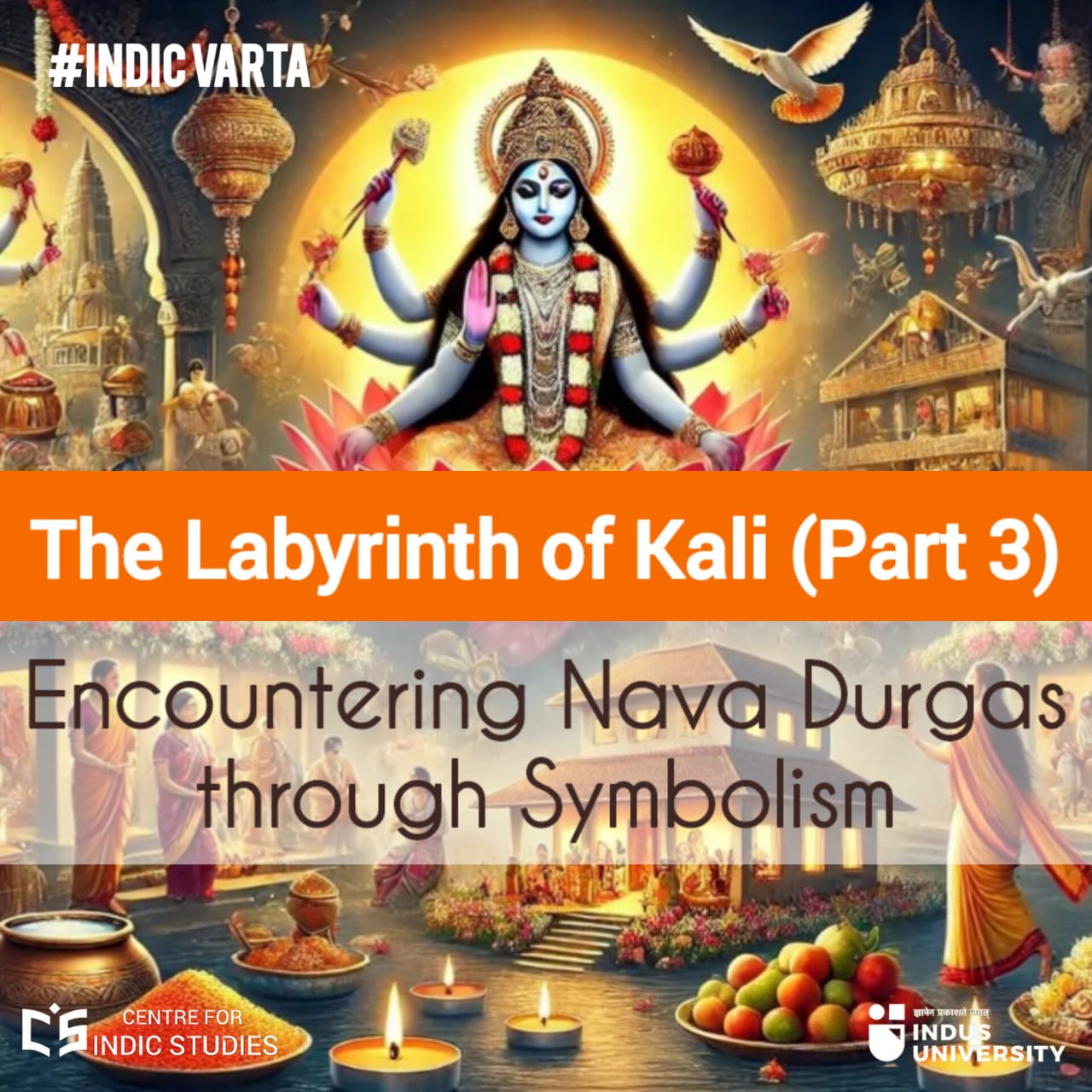- Visitor:22
- Published on:
The Divine Play of Emotions
Just as reading Tantric images through the lens of rasa unravels deeper aspects of visualization, engaging Tantric philosophy in the discourse on emotion allows us to explore the relation of the self and emotions and to address negative emotions in a proper light.

Tantric rituals of visualization epitomize embodied theology and the fluidity of emotions. Just as many Tantric deities display the emotion of heroism, one of the Tantric practices instructs the practitioner to cultivate this specific emotion by maintaining the mood of heroism (vırabhava).
One of the most popular Sakta rituals in India, the worship of Durga- that involves making the statue of the goddess and participating in the celebratory chariot festival gives rise to a surge of heroic feeling. The deity imagery suggests the same theme of the gods subdued by demons and the supreme goddess protecting all three realms by defeating the demon. While the play of heroism in the act of her visualization may not be liberating in itself, all emotions including that of heroism capture Durga-’s phenomenal and transcendent aspects. The rasa experience here begins with the sensation of heroism and culminates with self-realization. While not central, the emotions of erotic experience and compassion are explicit in myths and visualizations of the goddess. The celebration of the goddess with dance, chants, and her display in the chariot, all evoke heroism, with subordinate emotions eliciting this central emotion. If the self were devoid of emotion, the Sakta paradigm of the centrality of Durga-, whose essence is heroic emotion, would be inconsistent.
In the practice of Bhairava, fear becomes instrumental to liberation. As his other names suggest, he is after all ‘fearsome’ (Bhısana, Bhayankara). The name Bhairava comes from his fearsome howl. His glaring eyes are frightening, and his large dark body with snakes, skulls, and the hides of elephant and tiger heightens the viewer’s sense of fear. Transforming fear through experiencing its concentrated image as Bhairava is the basis of the practice. The metaphors of the cremation ground and night suggest death: when visualizing Bhairava, the real gaze is upon death. While the central mood experienced here is fear, this experience of fear is nonetheless conducive to self-realization, as the course of practice culminates with Bhairava standing for the self, transcending fear and death.
The visible image or the emotions displayed are, in this sense, a gateway to its opposite: the journey that started with fear ends by transcending it. The centrality of the esthetic mood of fear (bhayanaka) is vivid in all forms of Bhairava practice. Just as the image of Durga- displays heroism along with other subordinate emotions, Bhairava’s imagery portrays fury (raudra), disgust (bıbhatsa), and heroism (vıra). Often invoked in a pair, Kalı and Bhairava bear many similar characteristics. These are also the central deities of Trika, the non-dual stream of Tantric practice. The embodiment of death at the end signifies immortality, as is vivid in the practice of Kalı. Bhairava’s journey begins with fear and culminates with fearlessness. These deities, following the philosophy of Abhinava, are mirror images of the self. This embodiment of negative emotions in the course of transcending them problematizes the theologies that view the divine only in positive terms. This also brings negative emotions from the periphery to the center.
Bhairava images bring to prominence the expressions of heroism, wrath, and fear. The Buddhist Tantric deity Heruka depicts similar meanings by embodying multiple emotions: his eyes suggest delusion, his ears are linked with anger, the mouth with greed, the nose with miserliness, and the torso with jealousy. The imagery of Cakrasamvara Heruka is detailed in such a way that the deity manifests one or another emotion through various gestures and weapons. For instance, the deity’s two weapons, the thunderbolt and bell, held in the uppermost hands, are described as signifying emptiness and compassion. His two arms embracing the goddess (Vajravarahı) suggest power and wisdom, and the raw elephant hide held by the next two arms represents ignorance. The dagger of the deity depicts the removal of pride. His staff signifies supreme bliss. The head of Brahma- that the deity carries displays his control over delusion. The deity subdues time and death, shown by striding atop two dark and red figures. The dark and subordinated figure, Yama, also indicates duality, and the deity that dominates him becomes a metaphor of non-duality. The gem that ties the deity’s hair indicates fulfillment of all desires and the crescent moon the deity wears signifies the Bodhi mind. Bhairava’s frowning face and tightly clenched teeth are the metaphors of overcoming negative emotions. The tiger hide covering the deity’s body suggests his heroism. In the same way, the skull cup filled with blood and held in Vajravarahı’s left hand signifies supreme bliss and her nudity is interpreted as her victory over passion.
Central to the imagery of Camunda is the emotion of disgust (bıbhatsa) and the goddess is visualized wearing a garland of heads. The argument of the non-dual Tantras is not just to identify the goddess with negative emotion, but also to identify her with the self, and along these lines, the self is embodied and emotions are integral to it. It is not that the experience of disgust is considered liberating, but that the awareness of the self while undergoing emotional states grants the liberating wisdom. When transformed into rasa, even the experience of disgust (bıbhatsa) has the primacy of sattva. What constitutes negativity in experiencing emotions is not the emotions per se but the basic moods that underly these experiences. This justifies encountering Camunda as enlightening. In other words, in all transformations, experience and the self are identical and the awareness of the self is embodied and enriched with emotions, whether negative or positive. The corporeal depiction of Camunda -as wearing entrails, consuming blood, fat, and meat, and riding a corpse, all elicit disgust, and like other images, she also evokes other emotions that are subordinate. Not only does this paradigm consider emotional growth as integral to spiritual progress, it also supports the claim that self and emotion are inseparable. Just like a calm ocean still holds the potential of the tsunami, negative emotions are not eradicated from the enlightened self, and just like the tides indicate the wind, emotions describe the active engagement of the self.
Another popular Tantric imagery is that of Chinnamasta-, whose visualization powerfully brings multiple emotions into action. The goddess stands astride a couple in amorous play, depicting erotic sentiment. She severs her own head, depicting heroism. She feeds her subordinates with her own blood, depicting compassion. Her action of severing her head and the three flows of blood oozing out also stimulates the emotion of perplexity (adbhuta). The very act of self-beheading also stimulates the emotion of fear. The emotions of disgust and anger can be generated by the sight of oozing blood, the spectacle of the goddess severing her own head, her companions celebrating her decapitation, and the ensuing bloodshed. The characters in this visualization, the couple in amorous play, her associates, and particularly the goddess herself, are smiling, depicting comic sentiment. The image of a deity, following this argument, is the constellation of emotions that are expressed in their true form, the self-nature, when expressed as rasa. In rasa experience, there is no simultaneous experience of various permanent moods, as one subordinates the other. In mystical experience, they all arise simultaneously as subordinate to a higher experience. In this process, first the emotions are turned into rasa experience, and then this experience is elevated, prolonging the duration of a single stream of thought-qua-emotion, eventually turning into bliss-awareness.

The images of deities, in the rasa paradigm, function to carry out two roles: one to invoke the inner rasa experience through external stimuli and in this case, their functioning is similar to any esthetic object, and the next is to transform that rasa experience to the experience of the absolute, Brahman. Following this perspective, the external support of visualization, a mandala for instance, merely invokes inner states, allowing the practitioner to encounter the mirror image of the self. External stimuli are experienced in fragments in either case, and thus the complete artwork is subjective: here, real visualization occurs. In the realized state, there is no experience that is not part of the very absolute, and so there is actually no dichotomy between the two. The difference, however, is in complete transformation in the case of mystical experience, while a simple rasa experience is less powerful in transforming psycho-somatic conditions of the experiencing subject. When reported, the esoteric experience occurring through visualization is still a rasa experience. However, it liberates the subject from external stimuli and the subject is not dependent upon the visualized object for the surge of elevated bliss, and he is able to regenerate this experience even in the absence of external stimuli. Understanding visualization allows one to recognize the harmony between esthetic rasa experience and the experience of the transcendent that is expressed through the divine images. Visualization, in this light, is not merely conjuring an image or relating it to abstract concepts, it is also an active engagement with archetypal emotions. All emotions in this elevated consciousness function as tools for enlightenment: the same emotions that tie ordinary consciousness to name and form and evoke passion or aversion also allow the reversal of gaze, turning towards the self. Deities such as Kalı – or Bhairava, along these lines, not only display emotions but also suggest that the viewers incorporate their emotions and experience liberation while being engaged in the world. Since the deities are repeatedly addressed as identical to the self in the non-dual paradigm, the emotions the deities display are not outside the self. Visualization, thus, aims to give the insight of the self while witnessing the play of emotions amid the turmoil of emotions.
The image of Kamesvarı – the goddess of desire and the controlling energy of the world – uniquely depicts the interplay of the self, consciousness, and emotion. The goddess is invoked as Sundarı – the beautiful one, and she suggests eroticism through her posture and gestures. With her two arms, she carries a sugarcane bow and five arrows comprised of five different flowers, and with the other two, she carries the goad that controls and the noose that binds. Even the deities invoked in her mandala, such as ‘she who enchants all’ (Sarvasammohinı), ‘she who entrances all’ (Sarvastambhinı), and ‘she who controls all’ (Sarvavasankarı), suggest her hypnotizing qualities. The Bha-vanopanis.ad equates Kamesvara, the consort of goddess Kamesvari – with pure consciousness and the very self, eternally filled with bliss. Following this text, Kamesvari – also invoked as Lalita – is portrayed as having a red hue and wearing red garments; the color describes the reflective aspect of awareness. The same text describes that her bow made of sugarcane refers to the mind, passion (raga) is suggested by the rope that binds, aversion (dvesa) is suggested by the goad the deity carries, and the five sense organs are indicated by the five arrows that the goddess holds. The centrality of erotic emotion is vivid in Bhagamalinı– the goddess who wears the garland of wombs and Nityaklinna– the eternally aroused goddess, two other emanations of Tripura. With heroism subordinate to eroticism, the imagery of the goddess exemplifies tender emotions and their role in the transformation of the self.
Just as the contrast between passion (raga) and aversion (dvesa) is essential in the discourse on rasa, so also is it central in deciphering Tantric images. The imagery of Kalı – vividly portrays aversion, contrasting the imagery of Tripura- that displays passion. The term raga in Sanskrit stands not only for passion, but also for the color red, and the goddess Tripura – is red in hue. Kalı’s dark body portrays the darkness of tamas that gives rise to negative emotions. She is additionally invoked as ta-ması – or the one filled with tamas. She is Maha maya- the cosmic ‘delusion’ (moha) who projects externality. At the same time, she also stands for the self-identified with pure consciousness. When examining the posture of Tripura-, her erotic gestures, shocking lust, amorously depicted body portrayed as red, completely clothed and youthful, her swelling breasts, all express passion. And she is nonetheless the goddess of liberation.
As explained above, emotions are not obstacles on the way to liberation but the very manifestation of the self to be actualized.
This thesis extends also to the emotion of experiencing tragedy that the goddess Dhumavatı portrays. The underlying myth of the hunger of the goddess, who, in her wrath mixed with hunger, eats her consort Siva, and the image of her roaming as a widow with her pitiful face, brings tragedy to the spotlight. While tragic emotion is at the center, the peripheral emotions of anger, disgust, and fear accompany the imagery. She can metonymically suggest hunger. What is essential to this discourse is, she is nonetheless the goddess of wisdom (Mahavidya), capable of granting liberation. This entire visualization of deities, particularly those depicting negative emotions, would not be meaningful, if the self were devoid of emotion. The paradigm of rasa allows us to address this in the proper light: emotions, even when eliciting pain, help cultivate self-awareness. The self, following this paradigm, does not exclude either emotions or the body.
This discussion allows us to reach the following conclusions.
- One, the paradigm of rasa facilitates addressing opaque Tantric images that are otherwise difficult to understand.
- Two, emotion and the self or consciousness do not constitute a polarity, but rather, they are one and the same entity manifest in different modes.
- Three, the dualistic model discredits emotions in the discourse of the self and dissociates embodiment from consciousness. A proper counter to this theory lies in Tantric visualization and the rasa theory.
- Finally, just as there are various emotions, particularly those found in the rasa experience that are culturally and linguistically construed, the assumptions regarding the self are also grounded on culture, and self-realization involves actualization of this embodied and emotional aspect of the self.
Just as reading Tantric images through the lens of rasa unravels deeper aspects of visualization, engaging Tantric philosophy in the discourse on emotion allows us to explore the relation of the self and emotions and to address negative emotions in a proper light.
[Source: Sthaneshwar Timalsina, Tantric Visual Culture: A Cognitive Approach (Routledge, 2015), 132-140]
Center for Indic Studies is now on Telegram. For regular updates on Indic Varta, Indic Talks and Indic Courses at CIS, please subscribe to our telegram channel !
- 11 min read
- 0
- 0










